英汉对比研究期末考试重点
英汉对比研究
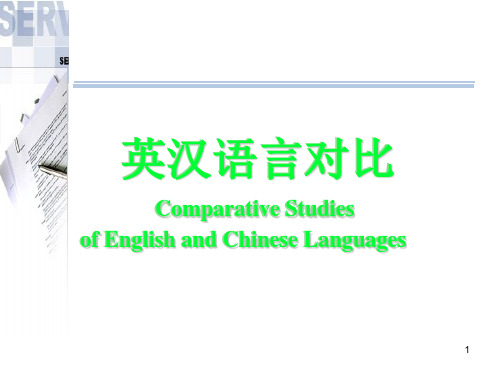
house that was built by Jack.
…
17
对.
不对.
他不对.
我认为他不对.
我告诉过你我认为他不对.
我明明告诉过你我认为他不对.
…16…
English: right-extending heavy-tailed like a peacock
This is the cat. This is the cat that killed the rat. This is the cat that killed the rat that ate the malt(麦芽). This is the cat that killed the rat that ate the malt that lay in the
英汉语言对比
Comparative Studies of English and Chinese Languages
1
A Contrastive Study in General
1、谱系 ( language family)
汉语 --- 汉臧语系 Sino-Tibetan
英语 --- 印欧语系 Indo-European
2、 类型 (type) 语言 的本质
汉语 --- 分析型 (analytical)
英语 --- 综合型 (synthetic);
2
3. 文字系统 (writing system)
汉语: 表意文字 (ideographic) 表意音文字
(ideo-phonographic)
汉英语言对比 期末考试
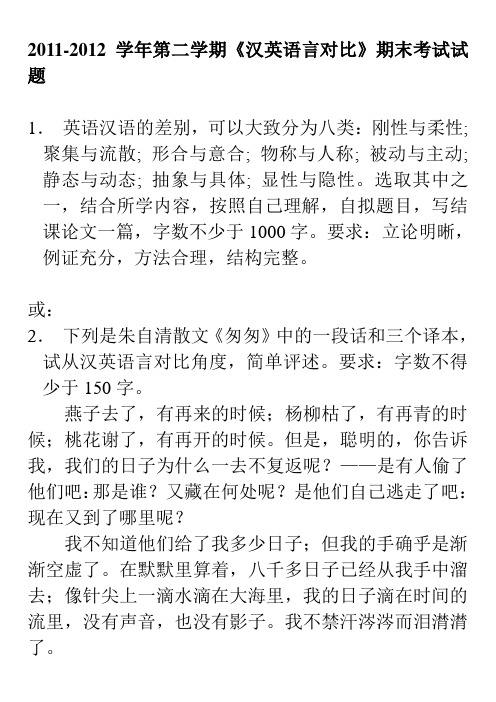
2011-2012学年第二学期《汉英语言对比》期末考试试题1.英语汉语的差别,可以大致分为八类:刚性与柔性; 聚集与流散; 形合与意合; 物称与人称; 被动与主动; 静态与动态; 抽象与具体; 显性与隐性。
选取其中之一,结合所学内容,按照自己理解,自拟题目,写结课论文一篇,字数不少于1000字。
要求:立论明晰,例证充分,方法合理,结构完整。
或:2.下列是朱自清散文《匆匆》中的一段话和三个译本,试从汉英语言对比角度,简单评述。
要求:字数不得少于150字。
燕子去了,有再来的时候;杨柳枯了,有再青的时候;桃花谢了,有再开的时候。
但是,聪明的,你告诉我,我们的日子为什么一去不复返呢?——是有人偷了他们吧:那是谁?又藏在何处呢?是他们自己逃走了吧:现在又到了哪里呢?我不知道他们给了我多少日子;但我的手确乎是渐渐空虚了。
在默默里算着,八千多日子已经从我手中溜去;像针尖上一滴水滴在大海里,我的日子滴在时间的流里,没有声音,也没有影子。
我不禁汗涔涔而泪潸潸了。
1)Rush (translated by Zhu Chunshen)Swallows may have gone, but there is a time of return; willow trees may have died back, but there is a time of re-greening; peach blossoms may have fallen, but they will bloom again. Now, you the wise, tell me, why should our days leave us, never to return? — If they had been stolen by someone, who could it be? Where could he hide then? If they had made the escape themselves, then where could they stay at the moment?I do not know how many days I have been given to spend, but I do feel my hands are getting empty. Taking stock silently, I find that more than eight thousand days has already slid away from me. Like a drop of water from the point of a needle disappearing into the ocean, my days are dripping into the stream of time, soundless, traceless. Already sweat is starting on my forehead, and tears welling up in my eyes.2)Transient Days (translated by Zhang Peiji)If swallows go away, they will come back again. If willows wither, they will turn green again. If peach blossoms fade, they will flower again. But, tell me, you the wise, why should our days go by never to return? Perhaps they have been stolen by someone. But who could it be and where could he hide them? Perhaps they have just run away by themselves. But where could they be at the present moment?I don't know how many days I am entitled to altogether, but my quota of them is undoubtedly wearing away. Counting up silently, I find that more than 8,000 days have already slipped away through my fingers. Like a drop of water falling off a needle point into the ocean, my days are quietly dripping into the stream of time without leaving a trace. At the thought of this, sweat oozes from my forehead and tears trickle down my cheeks.3)Days Gone By (translated by Zhang Mengjing)When the swallows have gone, there is still time to return; when the poplar and willow trees have become withered, there is still time to see green; when the peach flowers have already faded, there is still time to blossom. But please tell me, the genius, why then have my days gone and never returned? If some people have stolen them, then who are they? And where are they hidden? If they have escaped by themselves, then where are they now?I don't know how many days I have been given, but the in my hands are becoming numbered. Counting silently, eight thousand days have slipped by. Just like water drops a pinpoint dripping slowly into the vast ocean, my days been dripping into the river of time, quietly and invisibly. I can’t help dripping with sweat and weeping many tears.注:格式:5号宋体(英语部分用times new roman),题目用黑体。
《英汉对比研究》笔记

《英汉对比研究》笔记《英汉对比研究》笔记综合语与分析语聚集与流散形合与意合繁复与简短物称与人称被动与主动静态与动态抽象与具体间接与直接替换与重复第一章综合语与分析语综合语为“运用形态变化来表达语法关系”,如拉丁语、德语及古英语。
分析语为“用词序及虚词来表达语法关系”,如汉语。
英语为“综合-分析语”,表现为1.形态变化;2.固定的词序及丰富的虚词;英语为拼音文字,有语调(intonation);汉字为形声字,有声调(tone)表达语法意义的三大手段:形态变化、词序和虚词。
(一)形态变化,即词的形式变化。
1.构词形态,词缀变化(affixation),包括前缀(prefix)和后缀(suffix)。
英语有,汉语没有,所以英汉互译时,要改变词性、转换词类。
2.构形形态,即词形变化,包括人称代词,名词单复数和时态。
New factories are being built all over the country.全国到处都在兴建新工厂。
(二)词序形态变化越多的语言,词序越灵活,反之亦然。
英语词序比汉语灵活的一个表现就是英语中的倒装句。
原因就是“形态变化”和“连接词”;而中文缺乏形态变化,少用或不用连接词,词序较固定。
形态变化规则要求句中词语之间保持语法关系一致,只要词语之间前后呼应,就容易灵活安排;汉语无这种一致的关系,只能按照表意的需要排序词序。
a)He had to quit the position and went in exile, having beendeprived of his power.他被剥夺了权力之后,只好离职,流落他乡。
b)a very important questiona question of great importance一个很重要的问题c)at an unprecedented speedat a speed unprecedented以空前的速度d)There is no inconsistence in what he said.There is nothing inconsistent in what he said.他说的话并没有前后矛盾之处。
英汉语言文化比较期末重点
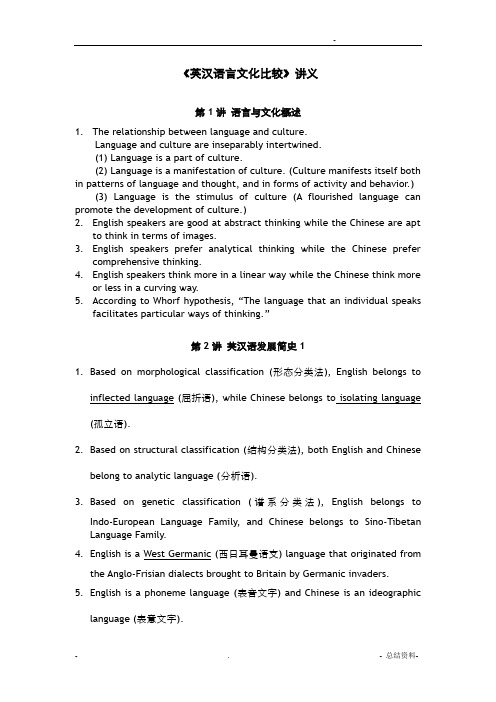
《英汉语言文化比较》讲义第1讲语言与文化概述1.The relationship between language and culture.Language and culture are inseparably intertwined.(1) Language is a part of culture.(2) Language is a manifestation of culture. (Culture manifests itself both in patterns of language and thought, and in forms of activity and behavior.)(3) Language is the stimulus of culture (A flourished language can promote the development of culture.)2.English speakers are good at abstract thinking while the Chinese are aptto think in terms of images.3.English speakers prefer analytical thinking while the Chinese prefercomprehensive thinking.4.English speakers think more in a linear way while the Chinese think moreor less in a curving way.5.According to Whorf hypothesis, “The language that an individual speaksfacilitates particular ways of thinking.”第2讲英汉语发展简史11.Based on morphological classification (形态分类法), English belongs toinflected language (屈折语), while Chinese belongs to isolating language (孤立语).2.Based on structural classification (结构分类法), both English and Chinesebelong to analytic language (分析语).3.Based on genetic classification (谱系分类法), English belongs toIndo-European Language Family, and Chinese belongs to Sino-Tibetan Language Family.4.English is a West Germanic (西日耳曼语支) language that originated fromthe Anglo-Frisian dialects brought to Britain by Germanic invaders.5.English is a phoneme language (表音文字) and Chinese is an ideographiclanguage (表意文字).6.The first people in England about whose language we have definiteknowledge are the Celts.7.After the Norman Conquest, English entered the period of Middle English.8.The period from 450 to 1150 is known as Old English. From 1150 to 1500the language is known as Middle English. The language since 1500 is called Modern English (1500-1700, early Modern English, 1700 until now, later Modern English).9.The main differences between Chinese words and English words: a)Letters in English are like strokes in Chinese. b) Morphemes in English are like radicals in Chinese. c) Chinese associative compounds (会意字) are like English compound words.第3讲英汉语发展简史21.Chinese and most related languages share features that make them unlikemost Western languages: They are monosyllabic, have even less inflection than English, and are tonal.2.In Chinese, a syllabic structure has three essential components: initials(声母), finals (韵母), and tones (声调). Chinese pinyin system has 21 initial consonants, 36 final vowels and 4 tones.3.According to Xu Shen’s (许慎) research, Chinese characters can be dividedinto six groups: 1) Pictographs (≈4%) 象形; 2) Ideographs (≈1%) 指事; 3) Logical Aggregates (≈13%) 会意; 4) Phonetic Complexes (≈82%) 形声; 5) Associative Transformations (a small portion) 转注; 6) Borrowings (a small portion) 假借.第4讲英汉语构词法1.Word formation in English:1)Compounding (合成法): T wo or more words are joined together toform a new word. (For example: home + work →homework)2)Prefixation (前缀法): Prefixation is the formation of new words byadding prefixes to stems. Prefixes do not generally change the word-class of the stem but only modify its meaning. (For example:Pejorative prefixes (贬义前缀): mal-, pseudo-, mis-, ill-).3)Suffixation (后缀法): Suffixation is the formation of new words byadding suffixes to stems. Unlike prefixes which primarily change the meaning of the stem, the primary function of suffixes is to change the grammatical function of stems.4)Conversion (转化法): Conversion is a word-formation whereby a wordof a certain word-class is shifted into a word of another without the addition of an affix. It is also called zero derivation (零位派生). (For example: 1) Problems snowballed by the hour. 2) Sandwich the two bread halves together and cut into 1-inch-wide slices.)5)Shortening (缩略法)6)Blending (拼缀法): Blending is a process of word-formation in which anew word is formed by combining parts of two words. The result of such a process is called a blend. Blending is a process of both compounding and abbreviation. For example, smog (smoke+fog).7)Back-formation (逆成法): a process of word-formation by which aword is created by the deletion of a supposed suffix. It is also known as a reverse derivation.8)Eponyms9)T oponyms2.Word formation in Chinese:1)The overwhelming majority of the Old-Chinese morphemes aremono-syllabic.2)61% of the 3,000 most commonly used Chinese words are disyllabic.3)Chinese prefixes mostly involve morphemes such as 老, 小, 第, and初.4)Some so-called Chinese suffixes are added as a way of nominalization,like 度, 性, etc.第5讲英汉词语的文化涵比较11.In Chinese, the word xīn (心) that primarily denotes the heart organ mayalso refer to the “organ for thinking”and the “seat of thought and emotions”.2.In contrast, according to the Western view, heart is seen as the center ofemotions/feelings and the head (the locus of the brain with which the mind is associated) as the center of thought.3.Based on the metaphor “heart as a physical entity”, the following wordsare formed in Chinese: 心房, 心窝, 心田, 心地, and 心弦.4.Research proves that if a language only has two color words, they must beblack and white; if the language has the third color word, it must be red;if it has the fourth one, it must be yellow or green.第6讲英汉词语的文化涵比较21.Dog has a negative connotation in “a dog in the manger”.2.Traditionally, people have talked about “fixed expressions”, stressing thefixedness of these expressions, but corpus studies have shown that many of the phrases can actually be varied.3.An idiom is a fixed or semi-fixed expression whose meaning cannot bededuced from its parts. But very few idioms are 100% fixed.第7讲英语抽象名词和汉语具体名词1.The plural forms of abstract English nouns often have the function ofconcretization, for example, ratings, attractions and breakdowns.第8讲形合与意合1.Hypotaxis (形合): The dependent or subordinate relationship of clauseswith connectives. For example: It was cold because the snows came.2.Parataxis (意合): The arranging of clauses or phrases without connectivesshowing the relations between them. For example: It was cold; the snows came.第9讲英汉句法比较1. A topic-prominent language is a language that organizes its syntax toemphasize the topic–comment structure of the sentence. Chinese is considered to be a topic-prominent language, where the topic of the sentence takes precedence in the sentence.2. A subject-prominent language (e.g. English) is a language in which thegrammatical units of subject and predicate (S V) are basic to thestructure of sentences and in which sentences usually have subject-predicate structure.第10讲英语被动句和汉语主动句1.English uses far more passive sentences than Chinese./ Passive voicesentences are more common in English than in Chinese.2.Many sentences in English have inanimate/impersonal subjects (无灵主语),while Chinese use this pattern less frequently. For example, “The thick carpet on the corridor killed the sound of my footsteps.”第11讲语篇对比11.According to Halliday and Hasan, collocation is “cohesion that is achievedthrough the association of lexical items that regularly co-occur”. The association is achieved when the lexical items have a tendency to appear in similar lexical environments or when they are related lexicosemantically.2.a) This is a fine hall you have here. I’m proud to be lecturing in it.(Reference)b) This is a fine hall you have here. I’ve never lectured in a finer one.(Substitution)c) This is a fine hall you have here. I’ve never lectured in a finer. (Ellipsis)第12讲语篇对比21.The normal pattern to develop an English paragraph: topic sentence (mainpoint/ central thought) – supporting details.第13讲隐喻、文化和世界观1.Sports metaphors are used by all Americans, regardless of class,professions, race, age or gender. The reasons are as follows:1)Most Americans believe competition to be one quality that has madeAmerica great.2)“Being the best” American mentality has often turned everyday lifeinto a sport game. People compete in almost everything.3)American schools are another contributing factor to the Americansports mania. In many schools, athletics outweighs all other programsin terms of money and attention received.4)As a country, from the national to the local level, Americans go out oftheir way to honor athletes.2.The literal use of 吃includes 吃面, 吃饭. (not吃惊, 吃香, 吃官司, 吃败仗). The literal use of 吃饭includes 吃冷饭. (not 吃干饭, 吃闲饭, 吃软饭)第14讲基于语料库的英汉语比较与翻译考察1.Corpus (pl. corpora or corpuses): a collection of text, now usually inmachine-readable form and compiled to be representative of a particular kind of language and often provided with some kind of annotation.2.Parallel corpus is most useful for translation studies.第15讲个人主义与集体主义1.Highly individualistic cultures include the U.S., Australia, Great Britain,Canada, the Netherlands, New Zealand, and Italy. Some examples of collectivist cultures include India, Japan and China.Short Answer Questions:1.What are the different types of transliterations (音译)? Give theChinese borrowings from English as examples.Answer: The first type is phonetic loans: 摩登、咖啡、咖喱、巧克力、克隆。
汉英翻译期末考试整理

汉英翻译期末考试整理————————————————————————————————作者:————————————————————————————————日期:她望着蔚蓝的大海。
She looked at the blue sea.武行者心中要吃,哪里听他分说,一声喝道:“放屁!放屁!”Pass your wind! Nonsense彩云红雨暗长门,翡翠枝余萼绿痕。
As rainbow clouds o’er darkened door, red petals shower,On jadeite branch is left the trace of fallen flower.接受竟成了劫搜。
Taking-over turns out to be loot-taking.他们种庄稼和葡萄,酿酒和饮酒,喂牛和挤奶,锄草。
(1)They plant crops and grapevines, brew and drink wines, feed and milk cows, and weed and plant the garden.(2) They plant crops and grapevines, brew wine to drink, feed cows to milk and weed the garden to grow flowers.(3) They plant crops and grapevines, brew wine for drink, feed cows for milk and weed the garden for flowers.(4)They plant crops and grapevines, do the gardening, brew wine for drink, and feed cows for milk.去教堂祈祷和做礼拜They go to the church to pray and attend church service.They go the church, praying and attending church service.到广场拉琴、跳舞和唱歌a. They play the violin, dance and sing.b. They play the violin, dancing and singing.c. They play dance and sing to the violin.21世纪前10年,是中国民航承前启后,继往开来的重要时期。
汉英翻译教程期末考试复习要点
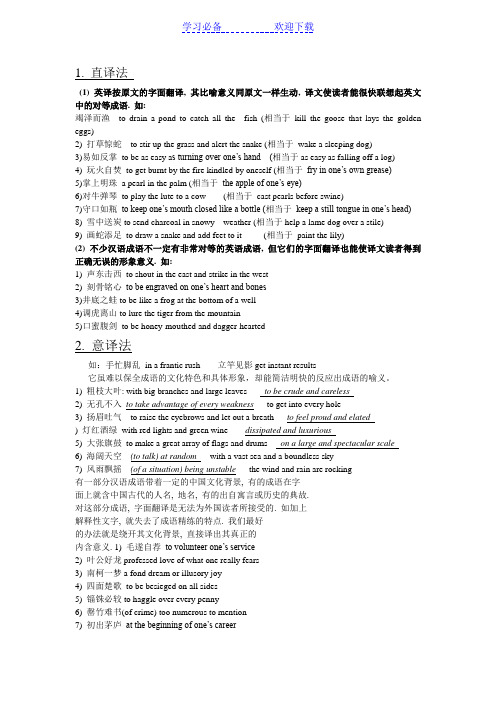
1. 直译法(1) 英译按原文的字面翻译, 其比喻意义同原文一样生动, 译文使读者能很快联想起英文中的对等成语. 如:竭泽而渔to drain a pond to catch all the fish (相当于kill the goose that lays the golden eggs)2) 打草惊蛇to stir up the grass and alert the snake (相当于wake a sleeping dog)3)易如反掌to be as easy a s turning over one’s hand (相当于as easy as falling off a log)4) 玩火自焚to get burnt by the fire kindled by oneself (相当于fry in one’s own grease)5)掌上明珠a pearl in the palm (相当于the apple of one’s eye)6)对牛弹琴to play the lute to a cow (相当于cast pearls before swine)7)守口如瓶to keep one’s mouth closed like a bottle (相当于keep a still tongue in one’s head)8) 雪中送炭to send charcoal in snowy weather (相当于help a lame dog over a stile)9) 画蛇添足to draw a snake and add feet to it (相当于paint the lily)(2) 不少汉语成语不一定有非常对等的英语成语, 但它们的字面翻译也能使译文读者得到正确无误的形象意义. 如:1) 声东击西to shout in the east and strike in the west2) 刻骨铭心to be engraved on one’s heart and bones3)井底之蛙to be like a frog at the bottom of a well4)调虎离山to lure the tiger from the mountain5)口蜜腹剑to be honey-mouthed and dagger-hearted2. 意译法如:手忙脚乱in a frantic rush 立竿见影get instant results它虽难以保全成语的文化特色和具体形象,却能简洁明快的反应出成语的喻义。
英汉对比与翻译期末复习指南
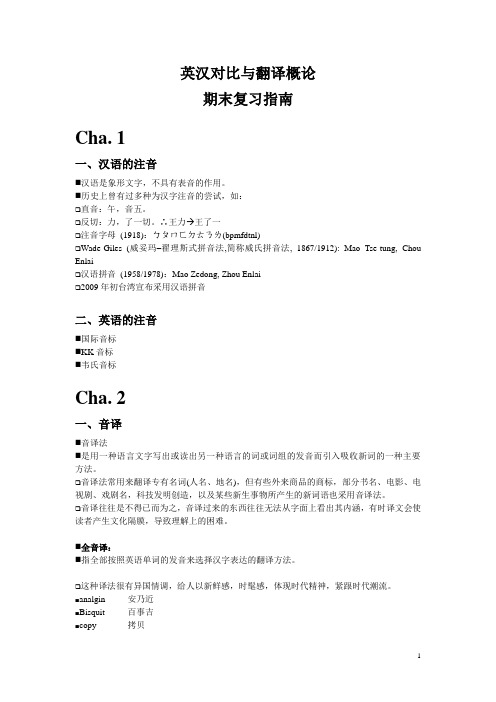
英汉对比与翻译概论期末复习指南Cha. 1一、汉语的注音⏹汉语是象形文字,不具有表音的作用。
⏹历史上曾有过多种为汉字注音的尝试,如:❑直音:午,音五。
❑反切:力,了一切。
∴王力→王了一❑注音字母(1918):ㄅㄆㄇㄈㄉㄊㄋㄌ(bpmfdtnl)❑Wade-Giles (威妥玛–翟理斯式拼音法,简称威氏拼音法, 1867/1912): Mao Tse-tung, Chou Enlai❑汉语拼音(1958/1978):Mao Zedong, Zhou Enlai❑2009年初台湾宣布采用汉语拼音二、英语的注音⏹国际音标⏹KK音标⏹韦氏音标Cha. 2一、音译⏹音译法⏹是用一种语言文字写出或读出另一种语言的词或词组的发音而引入吸收新词的一种主要方法。
❑音译法常用来翻译专有名词(人名、地名),但有些外来商品的商标,部分书名、电影、电视剧、戏剧名,科技发明创造,以及某些新生事物所产生的新词语也采用音译法。
❑音译往往是不得已而为之,音译过来的东西往往无法从字面上看出其内涵,有时译文会使读者产生文化隔膜,导致理解上的困难。
⏹全音译:⏹指全部按照英语单词的发音来选择汉字表达的翻译方法。
❑这种译法很有异国情调,给人以新鲜感,时髦感,体现时代精神,紧跟时代潮流。
⏹analgin 安乃近⏹Bisquit 百事吉⏹copy 拷贝⏹Delicious 得利斯⏹Fiyta 飞亚达⏹Kodak 柯达⏹Ford 福特⏹Lactov 乐口福⏹Lucky 乐凯⏹Paloma 百乐满⏹party 派对⏹Polaroid 宝利莱⏹salad 色拉⏹shampoo 香波⏹toast 吐司⏹部分音译部分意译:⏹指在英语名词音译前或后再加上说明性文字,让人们知道该名称的性质是什么。
❑但随着该词的流行和接受程度,意译部分逐渐淘汰,弃而不用。
⏹B owling 保龄球⏹Cookies 曲奇饼⏹Clean & Clear 可伶可俐洗面奶⏹Disco 迪斯科舞⏹Jacket 夹克衫⏹Golf 高尔夫球⏹Good 古德面包⏹Head & Shoulders 海飞丝洗发露⏹Jeep 吉普车⏹More 摩尔香烟⏹Pizza 比萨饼⏹Safeguard 舒肤佳香皂⏹Sardine 沙丁鱼罐头⏹Toffee 太妃糖⏹Top 脱普洗头膏⏹Sony 索尼电器⏹Waltz 华尔兹舞⏹约定俗成的译名不应重新改译,最好尽量保留原译名。
英汉语言对比_华中科技大学中国大学mooc课后章节答案期末考试题库2023年
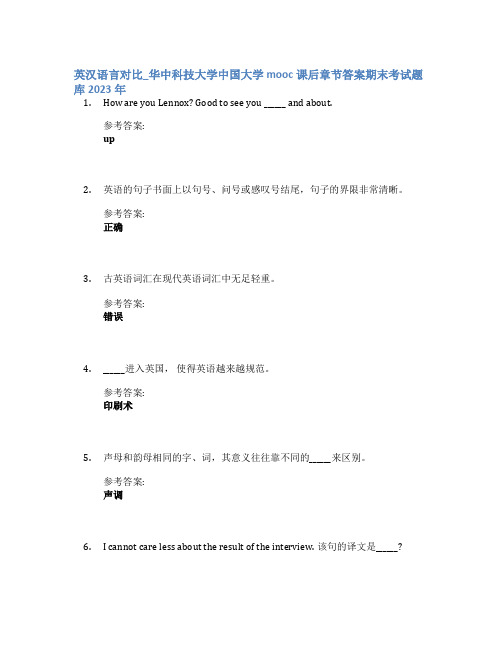
英汉语言对比_华中科技大学中国大学mooc课后章节答案期末考试题库2023年1.How are you Lennox? Good to see you ______ and about.参考答案:up2.英语的句子书面上以句号、问号或感叹号结尾,句子的界限非常清晰。
参考答案:正确3.古英语词汇在现代英语词汇中无足轻重。
参考答案:错误4.______进入英国,使得英语越来越规范。
参考答案:印刷术5.声母和韵母相同的字、词,其意义往往靠不同的______来区别。
参考答案:声调6.I cannot care less about the result of the interview. 该句的译文是______?参考答案:我一点也不在乎这次面试的结果。
7.汉语的被动式所表达的一般是不如意或不企望的事情参考答案:正确8.I'd do it with pleasure, only that I am too busy. 该句的译文是______?参考答案:我很高兴去做这件事,只是我太忙了做不了。
9.隐喻类似于传统意义上修辞学中的暗喻,指人们用一个具体的概念来理解另一个抽象概念的方式。
参考答案:正确10.英语的结构被动句要比汉语结构被动使用频率高得多。
参考答案:正确11.汉语中的婚姻表达比英语中包含更多的容器隐喻。
参考答案:正确12.“他最近情绪很低落。
"该句的译文是 He's been so ______ lately.参考答案:down13.“望子成龙”的译文是“to hope one's children will ______”。
参考答案:have a bright future14.“pull one's leg”的译文是______?参考答案:开玩笑15.“喜结连理,百年好合。
”该句中包含的婚姻隐喻是______?参考答案:婚姻是连接16.连动结构中所有动词与同一主语构成主谓关系。
中外翻译理论期末考试点
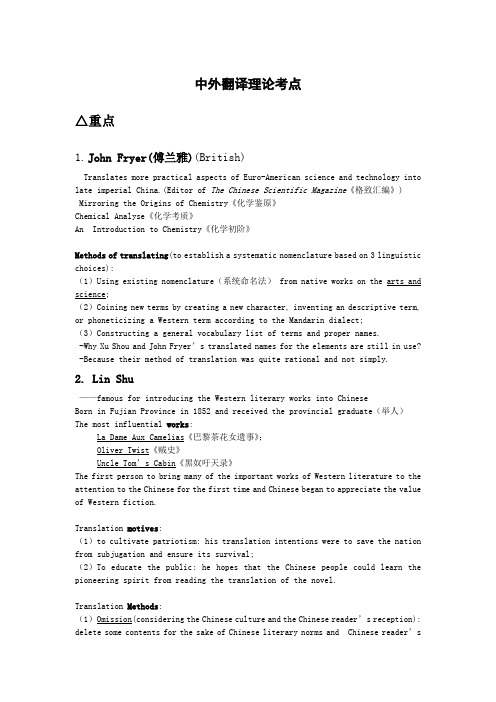
中外翻译理论考点△重点1.John Fryer(傅兰雅)(British)Translates more practical aspects of Euro-American science and technology into late imperial China.(Editor of The Chinese Scientific Magazine《格致汇编》)Mirroring the Origins of Chemistry《化学鉴原》Chemical Analyse《化学考质》An Introduction to Chemistry《化学初阶》Methods of translating(to establish a systematic nomenclature based on 3 linguistic choices):(1)Using existing nomenclature(系统命名法) from native works on the arts and science;(2)Coining new terms by creating a new character, inventing an descriptive term, or phoneticizing a Western term according to the Mandarin dialect;(3)Constructing a general vocabulary list of terms and proper names.-Why Xu Shou and John Fryer’s translated names for the elements are still in use? -Because their method of translation was quite rational and not simply.2.Lin Shu——famous for introducing the Western literary works into ChineseBorn in Fujian Province in 1852 and received the provincial graduate(举人)The most influential works:La Dame Aux Camelias《巴黎茶花女遗事》;Oliver Twist《贼史》Uncle Tom’s Cabin《黑奴吁天录》The first person to bring many of the important works of Western literature to the attention to the Chinese for the first time and Chinese began to appreciate the value of Western fiction.Translation motives:(1)to cultivate patriotism: his translation intentions were to save the nation from subjugation and ensure its survival;(2)To educate the public: he hopes that the Chinese people could learn the pioneering spirit from reading the translation of the novel.Translation Methods:(1)Omission(considering the Chinese culture and the Chinese reader’s reception): delete some contents for the sake of Chinese literary norms and Chinese reader’staste;(2)Addition(considering reader’s expectation): to publish and improve the original and also to help the readers to understand the original and the Western tradition, making the translation more interesting and attractive and appealing; (3)Alteration(considering the Chinese reader’s aesthetic tendencies): due to the social and cultural differences between the source and target languages, he made some compensation or replacement;(4)Adaptation(considering the feudal Chinese ethics)Criticism of his Translations:(1)the choice of the source text(2)Mistranslation and Incorrect OmissionContributions of his Translation:(1)to reconsider the value of fiction as a genre(2)To change people’s disregard of foreign literature(3)To exert a tremendous influence on later generation3.Fu LeiSome of his translations:Eugenie Grandet《欧也妮·葛朗台》Le Pere Goriot《高老头》Jean Christophe 《约翰·克里斯多夫》Translation Ideas:(1)Spiritual Resemblance Theory: In terms of effect, translation should be the same as copying painting, for what is searched for is spiritual similarity rather than formal similarity; Translation would be easy if breaking the structure, and characteristics of the native language could convey the features of the foreign language and obtain the original spirit; The meaning and spirit of the original, the fluency and integrity of the translation could be combined in one.(2)Translating as a holy career: Those who are not poets should not translate poetry, for what they produce will not only be unpoetic and it will not be like prose either; Measures of our adaptability: our enthusiasm about the original work since emotional interest affects understanding and our artistic insight.Whatever the style of the original, it will always be unified and coherent.(3)Language of translation: paying too much attention to grammar, syntax and style is definitely not conductive to the creation of great works.He can hardly achieve translating it into Chinese to convey the tone of the original text and reproducing the mood and atmosphere in the translation.But it can serve as an important link between what goes before and what comes after in the original text.4.Qian Zhongshu(Fortess Besieged)Works of translation: On the Art of Poetry《谈艺录》;The Pipe-Awl Chapters《管锥编》Translation Ideals:Realm of transformation(化境):describes what an ideal translation is like, differentiates the good translation from the bad, and contains hidden echoes of similar terminology from traditional Chinese poetics and art criticism.(1)The highest standard in literary translation is “化”, transforming a work from the language of one country into that of another, this could be done without betraying ant evidence of artifice by virtue of divergences in language and speech habits, besides, preserving intact the flavor of the original.(2) a translation should cleave to the original with such fidelity that it would not read like a translation, for a literary work in its own language will never read as though it has been through a process of translation.(与奈达的动态对等理论相似)(3)Misrepresentation:讹.The words transmit and entice explain how translation functions in cultural interchange; it acts as a middleman, a liaison as though playing the role of matchmaker and bringing about a “literary romance”between nations.(4)Translation was to save people the trouble of learning foreign languages and reading the original works,but now it entices the readers into doing the very thing. It arouses the reader’s curiosity, causing them to yearn for the original.(5)The Chinese character for “translation”译has etymological and associative connections with the characters for “seduction”诱,“error”讹,“mediator”媒 and “transformation”化(6)Sublimity,化: changing the form and retaining the content and style or spirit at the same time; a translation should be both smooth and idiomatic in the target language; should be faithful to the original in content or spirit and style;is an all but unrealizable ideal.5.JakobsonHe experimented with “supraconscious”(超意识的)poems, the co-founder of both the Moscow Linguistic Circle and the Prague Linguistic Circle.His essay “On Linguistic Aspects of Translation” extends the significance of translation to include intralingual and intersemiotic translation.His emphasis on the functional role of linguistic elements in the translated text had a positive effect on the work of poetry translators3 kinds of translation are to be differently labeled:(1)Intralingual translation or rewording is an interpretation of verbal signs by means of other signs of the same language;(2)Interlingual translation or translation proper is an interpretation of verbal signs by means of some other language;(3)Intersemiotic translation or transmutation is an interpretation of verbal signsby means of signs of nonverbal signs systems.Equivalence in difference is the cardinal problem of language and the pivotal concern of linguistics.(差异对等是语言的基本问题,也是语言学的核心问题)6.CatfordFundamental Problems in PhoneticsTranslation Ideals:(1)The definition of translations: translation is the replacement of textual material in one language (SL)by equivalent textual material in another language(TL).(2)The general types of translationCatford saw language as a set of systems operating at different levels, and described broad translation types using three sets of criteria:A.in terms of the extent of translation, he distinguished between full translationB.In terms of the levels of language involved in translation, a distinction is drawn between total translation and restricted translation(phonological translation and graphological translation)C.In terms of the grammatical or phonological rank at which translation equivalence is established, he distinguished between rank-bound translation and unbounded translation(3)Formal correspondence and textual equivalenceA formal correspondence is “any TL category(units, class, element of structure, etc); a textual equivalent is “any TL text or portion of text which is observed on a particular occasion.In his own words, translation shifts are thus “departures from formal correspondence in the process of going from the SL to the TL.”:1) A level shift would be sth. That is expressed by grammar in one language and lexis in another;2)Category shiftsa.structural shiftsb.Class shiftsc.Unit shifts or rank shifts: rank here refers to the hierarchical linguistic units of sentence, clause, group, word and morpheme.d.Intra-system shifts(4)The limits of translatability(可译性)It fails where the difficulty is linguistic and those where it is cultural(节日,特殊意象)7.Peter Newmark(Englishman)One of the main figures in the founding of translation studies in English-speaking world.Communicative translation and semantic translation(交际翻译和语义翻译)——main contribution to general translation theory Communicative translation:1)responds to the representational and vocative functions;2)Is likely to be smoother, simpler, clearer, more direct, more conventional, conforming to a particular register of language, tending to undertranslate.3)In some sense, communicative translation, by adapting and making the thought and cultural content of the original more accessible to the reader, gives semantic translation another dimension.4)The transition to communicative translation is basically makes the text smoother, lighter, more idiomatic and easier to read.5)“Standardized English”must be translated communicatively, whether a standardized equivalent exists or not, even if it appears in a novel or a quotation, unless the term is used descriptively rather than operatively in the original text.Semantic translation:1)attempts to recreate the precise flavor and tone of the original;2)Tends to be more complex, more awkward, more detailed, more concentrated, and pursues the thought-process rather than the intention of the transmitter to overtranslate, to be more specific than the original3)the transition to semantic translation normally reduces the unit of translation, and brings the text closer to the figurative and formal elements of the original.wrence Venuti(a distinguished American translation theorist, historian and translator) Translation Ideals:(1)Invisibility of the translator(译者的不可见性)The Translator’s Invisibility: A History of TranslationThe absence of any linguistic or stylistic peculiarities makes it reflects the foreign writer’s personality or intention or the essential meaning of the foreign text—the appearance, that the translation is not in fact a translation, but the “original.”The more fluent the translation, the more invisible the translator, and, presumably, the more visible the writer or the foreign text.(2)Foreignizing translation strategy(异化翻译策略)Venuti defined translation as a process by which the chain of signifiers(意符,能指) that constitutes the source-language text is replaced by a chain of signifiers in the target language which the translator provides on the strength of an interpretation.Because meaning is an effect of relations and differences among signifiers along a potentially endless chain(polysemous, intertextual, subject to infinite linkages) “resistancy”(异化、反翻译)Resistancy seeks to free the readers of the translation, as well as the translator, from the cultural constraints that ordinarily govern their reading and writing and threaten to overpower and domesticate the foreign text, annihilating(消灭) its foreignness. Resistance assumes an ideology of autonomy(自主性的意识形态), locating the alien(异己) in a cultural other, pursuing cultural diversity, foregrounding(突出) the linguistic and cultural differences of the source-language text(源语文本) and transforming the hierarchy of cultural values(文化价值层次)in the target languages.The translation of Buddhist scriptures:The initial period:An Shigao; Zhi Qian(Han Dynasty)The period of development:Dao’an (East Jin Dynasty); Kumarajiva(鸠摩罗什)The period of prosperity:Xuanzang(Tang Dynasty)Translation of western science(16—18AD,Ming Dynasty): Matteo Ricci(利玛窦)Italian Jesuit priest, one of the founding of the Jesuit ChinaMission.The first person to translate the Confucian classics into awestern language,Latin with assistance from the scholarXu Guangqi. They translated Euclid’s The Elements(几何原本)into Chinese.Xu Guangqi: he had coin so many new terms and to select carefully the accurateexpressions of mathematical concepts and contexts fromthe wide vocabulary of Chinese.Three Great Pillars of Chinese Catholicism(中国天主教的三大支柱):Matteo Ricci,Xu Guangqi,and Yang Tingyun(Summary of WesternLearning《西学凡》;On Geography《识方外纪》). Translations during Ming Dynasty had 2 distinguished characteristics:(1)the subject of translation shifted from Buddhist scriptures to scientific and technological knowledge;(2)Translators in this period of time were mainly scientists and government officials who were erudite scholars, and the Western missionaries who brought Western knowledge to China.The translation of science in the Late Qing Dynasty:Robert Morrison, Daniel Jerome,Benjamin Hobson, James Legge,Alexander Wylie. John Fryer.Yan Fu1.Famous for introducing Western thoughts, including Darwin’s idea of “natural selection” into China during the late 19th century.2.His heart was indeed not in technical translation but in the transmission of the political ideas which he had discovered in the West so he translated a number of key works of modern Western thought:1)Evolution and Ethics and Other Essays (天演论——赫胥黎)2)The Study of Sociology(群学肄言——斯宾塞)3)The Wealth of Nations(原富——亚当斯密)4)On Liberty(群己权界论——论自由,斯图亚特)Translation Theory: faithfulness, comprehensibility, elegance(信达雅)Hu ShiHu originally emphasized 8 guidelines that all Chinese writers should take to heart in writing:1)Writing with substance(要言之有物)2)Do not imitate the ancients3)Respect grammar4)Reject melancholy(不要无病呻吟)5)Eliminate old cliches(杜绝陈词滥调)6)Do not use allusions(典故)7)Do not use couplets or parallelism(对偶骈文)8)Do not avoid popular expressions(俗话俗字)or forms of characters Translation Ideals:(1)Choosing those masterpieces of famous writers only;(2)Adopting a vernacular prose style in the translation of those dramas of a verse style. He adopted a unity of faithfulness and expressiveness1) a translator should be responsible for the author to keep the spirit of the original and secondly be responsible for the readers and make his version intelligible.2)The literary works that were hard to understand could never succeed in educating people, and thus clearness in meaning is of primary importance in literary translation.Practice: Over the Roofs《关不住了》;Book of Experiments《尝试集》Lu Xun’s translation ideals:he insisted that “he would rather be faithful to the original than be fluent to the translation(宁信而不顺)”, he stressed that it was a special class of readers that his translations were intended for the proletariat literary critics who had special class interests to champion. Extreme faithfulness to the original was a way ensuring that “true” Marxist literary thought be presented to those who wanted the facts as they were.He said “The Chinese language is just too imprecise, and to this ailment, I believe we have to suffer some more pain and embody our thought in wayward syntactical structures——ancient, dialectal, as well as foreign so that one day these structures can become our own.”Practice: From the Earth to the Moon in 97hours 12 minutes.Zhou ZuorenTranslation ideals: prefers straightforward translation, that is : it should convey the original meaning and preserve the original style and express the original meaning as far as our Chinese language can do. In other words, it is faithfulness and expressiveness,Practice: Ali Baba《侠女奴》Liang ShiqiuTranslation ideals:having a book translated is to make it comprehensible, mistranslation is indeed unacceptable. Even though partialmistranslations are mistakes that may really be endlessly harmful,you have nevertheless enjoyed reading them. It would not do anyharm to modify the syntax somewhat and to make it peremptory sothat the text becomes intelligible to the reader because it’s nopleasure to grind through a text while stiff translation can notpreserve the original tone of terseness and conscious.Dead translation is very different, which is bound to be dead frombeginning to end and makes no difference whether it is read or not,also,dead translation might as well involve distorted translation. Major works: Peter Pan《彼得潘》,Wuthering Heights《咆哮山庄》;Meditation《沉思录》Lin YutangWorks of translation:The Chinese Puzzle《国民革命外纪》Women and Knowledge《女子与知识》Pygmalion《卖花女》《庄子》Chuangtse《浮生六记》Six Chapters of a Floating LifeTranslation Theory:On Translation《论翻译》:he pointed out that “translation is an art”.On Poetry Translation《论译诗》He pointed out three “responsibility”and explained the implication.He also proposed three criteria for translation: faithfulness, fluency, and beauty (忠实、通顺和美)He assumed four types of translation concerning the degree of faithfulness: literal, dead, free, and random translation.Words of each language have the beauty of sound,meaning,spirit, form, literary style and literary form.Zhu ShenghaoZhu’s work made up the core of the mainland-Chinese version of The Complete Works of Shakespeare, and the first volume is made up of 9 comedies while the second consists of 8 tragedies.Translation Ideals:(can be revealed from his self-preface of The Complete Plays of Shakespeare.) The preface consists of five paragraphs:(1)the significance of Shakespeare;(2)The situation of Shakespeare translation in China(3)His experience of translating Shakespeare and hardship involved in this process(4)His method of translating Shakespeare: to preserve the original spirit as far as possible; and if not, he made his best to put the original meaning into clear and readable Chinese. He strongly objected was word-to-word stiff translation. After finishing a paragraph, he would pretend to be a reader or a performer.Yang XianyiAccomplishment of translation: A Dream of Red Mansion, Li SaoHe acknowledged his wife’s significance in their translation——Collaborationtranslation.Translation Ideals:(1)Faithfulness: a translation should not be far from the original but not word-to-word translation.(2)Culture and translation: Translation is more than language switching. What more important is the culture behind the words.(3)Poetry translation with or without rhyme: Keeping the rhyme is secondary to keeping the meaning and it is impossible to keep everything in translation because of the differences in the two cultures.Yu GuangzhongHis works often focused upon four fundamental aspects of literature:poetry, prose, translation and commentary.Works: The Old Man and the Sea,Anthology of Modern English and American Poetry.Translation Ideals:1)The fundamental similarities and differences between translation and creative writing: if a writer also translate, his translation style will inevitably be affected by his own creative writing style, conversely, his own writing style will not remain unaffected.2)Translation is a ‘necessary evil’, a substitute we rely on for lack of something better. Not even a good translation can convey the true meaning of the original. In case of bad translations, besides distorting the original meaning, they often have a pernicious impact on indigenous writing styles.Theodore Savory (文艺学派)The Language of Science; Words of ScienceDifficulties in his search for the equivalent of a word:(1)Illusory Correspondence: a word often has several meanings and the translator should take the context into consideration when choosing an appropriate word in the target language.(2)Gaps in languages which cannot be filled in translating: because a word may be quite familiar in one language but there is no equivalent one in another. All kinds of writings where the two nations whose languages are concerned may have different customs, different games and amusements and different degrees of technical development.(3)Idioms, idiomatic phrases and provisional expressions:he suggested that the translator should ask himself 3questions:(a)what does the author say?(b)What does he mean?(c)How does he say it?A good translator’s knowledge of the translated language must be wide and it must also be critically applied so that no detail is likely to be missed. Categories of translation:(1)perfect translation:refers to the translation of all purely informative statements such as are encountered by the traveler or used by the advertiser.(2)Adequate translation:matter is more important than manner(内容比形式更重要)(3)Composite translation:includes the translation of prose into prose, of poetry into prose and of poetry into poetry(4)Translation of learned, scientific, technical and practical matter.The principles of translation:made solely because of the intrinsic importance of the original work, which is strictly confined to the practical business of living; It is almost a necessity that the translator shall have a reasonable knowledge of the science or the technique about which the original was written.The Principle of Translation:(1) A translation must give the words of the original.(2)~must give the ideas of the original(3)~should read like an original work(4)~should read like a translation(5)~should reflect the style of the original(6)~should possess the style of the translator(7)~should read as a contemporary of the original(8)~should read as a contemporary of the translator(9)~may add to or omit from the original(10)~may never add or to omit from the original(11)~of verse should be in prose(12)~of verse should be in verse.We need to choose different words in different contexts.Eugene Nida’s Translation TheoryMain Translation Ideas(1)Two basic orientations in translating:formal and dynamic equivalence.1)D ynamic-equivalence attempts to convey the thought expressed in a source text ;2)F ormal-equivalence attempts to render the text word-for-word.(2)Principles governing a translation oriented toward formal equivalence:1)g rammatical units;2)C onsistency in word usage;3)M eaning in terms of the source context;(3)Principles governing a translation oriented toward dynamic equivalence(动态对等): the most notable contribution; elaborated in “Principles of Correspondence”and it stands to reason that there can be no absolute correspondence between two languages. It’s the closest natural equivalent to the source-language message.But here are some limitations:1)special literary form,2)semantically exocentric expressions(语义外向),3)intraorganismic meaning.(4)Principles governing a translation oriented toward functional equivalence.Terms Explanation1.Five Losses:Dao’an(1)Sanskrit and Chinese are in reversing word order in sentence structure, as far as grammar is concerned.(2)Sanskrit prefers to be simple and straight forward, while Chinese prefers to be complex, polished in writing.(3)Sanskrit tends to be repetitive for important points while Chinese does not.(4)Sanskrit always contains sentences within sentences while Chinese does not.(5)Sanskrit writing is repetitive in subsequent passage, while the repetitiongs are deleted in Chinese translations.2.Five Untranslatables:Xuanzangsecrets,polysemy,none in china,deference to the past,to inspire respect and righteousness:Prajna instead of “wisdom.”3.信达雅(严复)Translation involves three requirements difficult to fulfill:1)Faithfulness2)Comprehensibility:prime importance3)EleganceFaithfulness is difficult enough to attain but a translation that is faithful but not comprehensible is no translation at prehensibility is therefore of prime importance.4.直译(literal translation)Straightforward translation/direct translationFormal correspondenceWorld-to-word translation(逐字译)Stiff translation(硬译)(Lu Xun)5.意译(free translation)Sense-for-sense translation/sense translationSemantic correspondenceFree translation(自由译)Distorted translation(歪译)(Lin Shu)6.Dead transportation: not only putting every word and every sentence in the same order as the original, but also not allowing the addition of a single word or even the change of the same order of any words.7. Three Responsibilities(a)The translator should have a complete understanding of the language and contents of the source text.(b)The translator should have a good command of Chinese so that he can produce a smooth and expressive version.(c)The translator should be trained properly to hold proper opinions on the standards and techniques of translation.9.Three Criteria1)Faithfulness: the first responsibility for the translator to fulfill but it doesn’t mean a word-to-word translation. A faithful version will not only convey the meaning of the source text but also spirit of the words and their implications.It is not possible to achieve absolute faithfulness.2)Fluency: a fluent translation should be based on sentence-to-sentence translation rather than word-for-word translation.3)Beauty: translation is an art and an ideal translator should make translationa fine art. So when we translate the Western literary text such as poetry and fiction into Chinese, we have to take its aesthetic value into consideration.。
英汉对比研究期末考试重点汇编
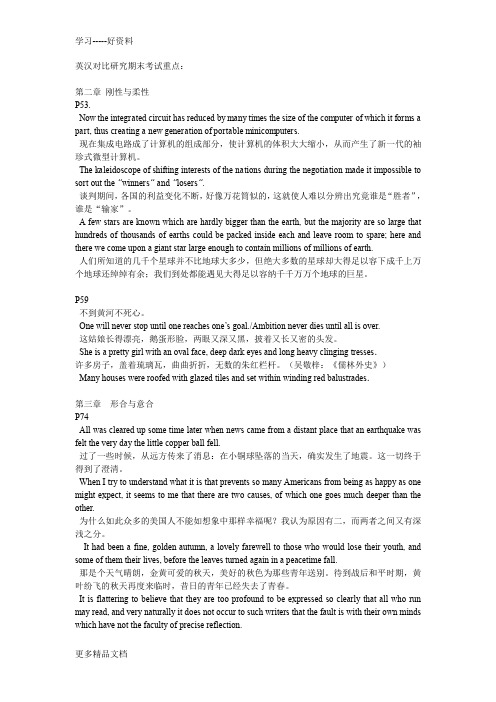
英汉对比研究期末考试重点:第二章刚性与柔性P53.Now the integrated circuit has reduced by many times the size of the computer of which it forms a part, thus creating a new generation of portable minicomputers.现在集成电路成了计算机的组成部分,使计算机的体积大大缩小,从而产生了新一代的袖珍式微型计算机。
The kaleidoscope of shifting interests of the nations during the negotiation made it impossible to sort out the “winners” and “losers”.谈判期间,各国的利益变化不断,好像万花筒似的,这就使人难以分辨出究竟谁是“胜者”,谁是“输家”。
A few stars are known which are hardly bigger than the earth, but the majority are so large that hundreds of thousands of earths could be packed inside each and leave room to spare; here and there we come upon a giant star large enough to contain millions of millions of earth.人们所知道的几千个星球并不比地球大多少,但绝大多数的星球却大得足以容下成千上万个地球还绰绰有余;我们到处都能遇见大得足以容纳千千万万个地球的巨星。
P59不到黄河不死心。
One will never stop until one reaches one’s goal./Ambition never dies until all is over.这姑娘长得漂亮,鹅蛋形脸,两眼又深又黑,披着又长又密的头发。
英汉语言对比_华中科技大学中国大学mooc课后章节答案期末考试题库2023年
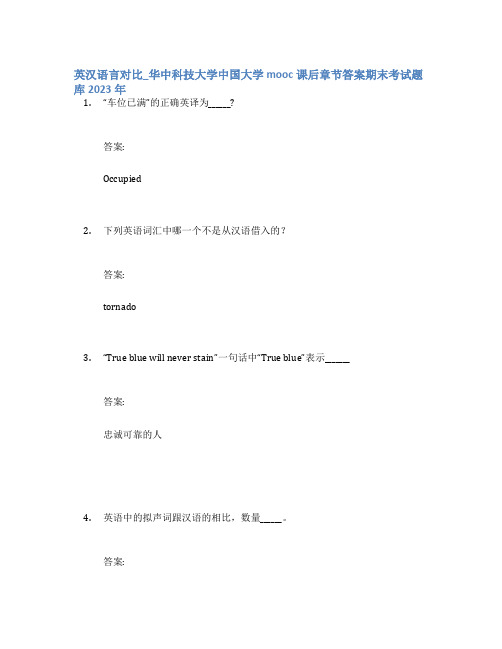
英汉语言对比_华中科技大学中国大学mooc课后章节答案期末考试题库2023年1.“车位已满”的正确英译为______?答案:Occupied2.下列英语词汇中哪一个不是从汉语借入的?答案:tornado3.“True blue will never stain”一句话中“True blue”表示_______答案:忠诚可靠的人4.英语中的拟声词跟汉语的相比,数量______。
答案:更多5.下列哪一个植物词语在英语中象征春天?答案:daisy6.英语姓氏中的前缀O'代表什么含义?答案:某人的后裔7.哪一个选项不是汉语姓氏的来源?答案:体型8."Long time no see."属于哪种借词方式?洋泾浜英语9.下列选项中哪一个词表示“卑劣、胆怯的人”?答案:yellow dog10.“bird dog”一词的意思为_______。
答案:寻找新人才的人、猎头11.“white feather”一词的比喻意义是_______。
答案:胆小12.汉语的大多数的抑扬顿挫是通过_______来实现的。
声调13.“我喜欢徒步,他也喜欢徒步”的正确译文是:_______?答案:I like hiking, so does he.14.We are told that he will come tonight, and if so, our meeting will be heldtomorrow.该句中的替代形式是_______?答案:分句性替代15.英语为______语言,因此需要______重复.答案:形合;避免16.Apple has just luanched its new iPhone and this gadget can be chargedwirelessly. 该句使用的是______变换手法。
答案:上下义词17.To err is human; to forgive, divine.该句中的省略形式是_______?答案:动词省略18.“blue book”的意思是_______。
汉英翻译期末考试整理版

她望着蔚蓝的大海。
She looked at the blue sea.武行者心中要吃,哪里听他分说,一声喝道:“放屁!放屁!”Pass your wind! Nonsense彩云红雨暗长门,翡翠枝余萼绿痕。
As rainbow clouds o’er darkened door, red petals shower,On jadeite branch is left the trace of fallen flower.接受竟成了劫搜。
Taking-over turns out to be loot-taking.他们种庄稼和葡萄,酿酒和饮酒,喂牛和挤奶,锄草。
(1)They plant crops and grapevines, brew and drink wines, feed and milk cows, and weed and plant the garden.(2) They plant crops and grapevines, brew wine to drink, feed cows to milk and weed the garden to grow flowers.(3) They plant crops and grapevines, brew wine for drink, feed cows for milk and weed the garden for flowers.(4)They plant crops and grapevines, do the gardening, brew wine for drink, and feed cows for milk.去教堂祈祷和做礼拜They go to the church to pray and attend church service.They go the church, praying and attending church service.到广场拉琴、跳舞和唱歌a. They play the violin, dance and sing.b. They play the violin, dancing and singing.c. They play dance and sing to the violin.21世纪前10年,是中国民航承前启后,继往开来的重要时期。
英汉语对比概论期末考试试卷
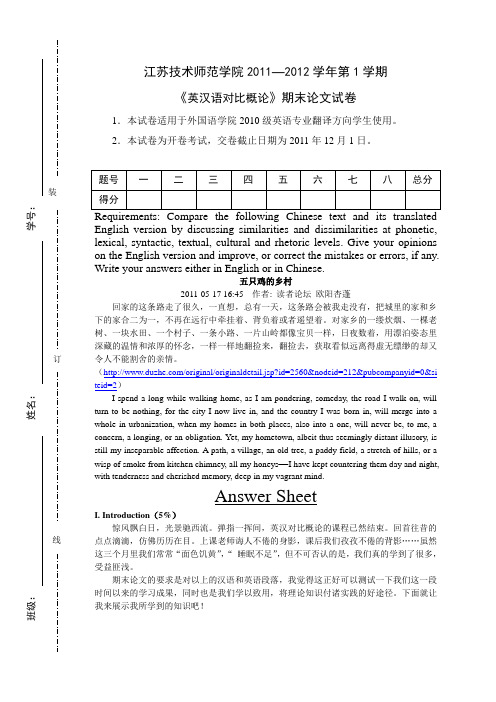
《英汉语对比概论》期末论文试卷1.本试卷适用于外国语学院2010级英语专业翻译方向学生使用。
2.本试卷为开卷考试,交卷截止日期为2011年12月1日。
English version by discussing similarities and dissimilarities at phonetic, lexical, syntactic, textual, cultural and rhetoric levels. Give your opinions on the English version and improve, or correct the mistakes or errors, if any. Write your answers either in English or in Chinese.五只鸡的乡村2011-05-17 16:45作者: 读者论坛欧阳杏蓬回家的这条路走了很久,一直想,总有一天,这条路会被我走没有,把城里的家和乡下的家合二为一,不再在远行中牵挂着、背负着或者遥望着。
对家乡的一缕炊烟、一棵老树、一块水田、一个村子、一条小路、一片山岭都像宝贝一样,日夜数着,用漂泊姿态里深藏的温情和浓厚的怀念,一样一样地翻捡来,翻捡去,获取看似远离得虚无缥缈的却又令人不能割舍的亲情。
(/original/originaldetail.jsp?id=2560&nodeid=212&pubcompanyid=0&si teid=2)I spend a long while walking home, as I am pondering, someday, the road I walk on, will turn to be nothing, for the city I now live in, and the country I was born in, will merge into a whole in urbanization, when my homes in both places, also into a one, will never be, to me, a concern, a longing, or an obligation. Yet, my hometown, albeit thus seemingly distant illusory, is still my inseparable affection. A path, a village, an old tree, a paddy field, a stretch of hills, or a wisp of smoke from kitchen chimney, all my honeys—I have kept countering them day and night, with tenderness and cherished memory, deep in my vagrant mind.Answer SheetI. Introduction(5%)惊风飘白日,光景驰西流。
英汉语言对比分析期末考试资料-副本
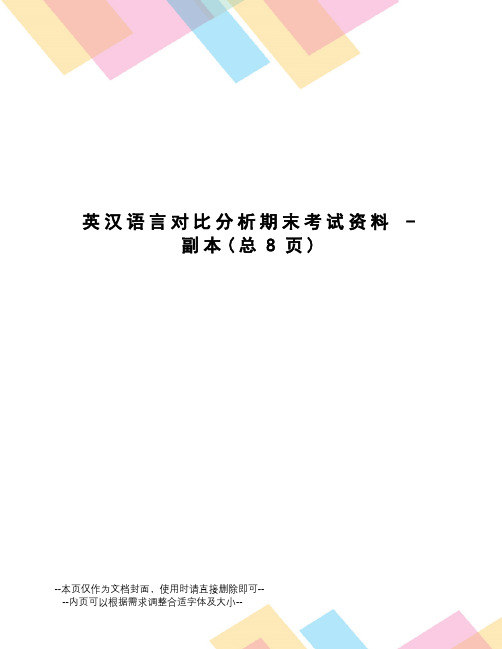
英汉语言对比分析期末考试资料-副本(总8页)--本页仅作为文档封面,使用时请直接删除即可----内页可以根据需求调整合适字体及大小--一引入Is Language Transfer?谈谈自己的想法并举两个例子Transfer is the influence resulting from the similarities and differences between the target language and any other language that has been previously acquired . Odlin (1989: 27)迁移是由于目标语与已经习得的语言之间的相似和差异而产生的影响。
奥德林Keen awareness of the similarities and differences between the two languages can facilitate FL learning.对两种语言相似与相异点的敏锐意识能促进外语学习。
Examples of Negative Transfer:He only eat two meal a day. Morphological transfer (词形迁移)Neither nouns nor verbs have inflections in Chinese. 在汉语中,名词和动词都没有形态变化。
Shanghai is said to have thirteen million population. Collocation transfer (搭配迁移)The noun renkou, the Chinese equivalent of ‘population’, can have a numerical pre-modifier. Population 的汉语对应词“人口”在汉语中可以用前置数词来修饰。
3.中文的竹式结构,英文的树式结构能够举例说明从前这里有一个渔村,村里住着十户人家,这十户人家全靠打鱼、种地为生,生活艰苦,但很安宁。
考研英语翻译比较结构的复习攻略

考研英语翻译比较结构的复习攻略考研英语翻译比较结构的复习攻略比较结构是考研英语翻译的热门考点之一,我们在复习的时候,需要抓住重点来复习。
店铺为大家精心准备了考研英语翻译比较结构的复习重点,欢迎大家前来阅读。
考研英语翻译比较结构的复习要点一、前肯后否结构:more ... than ...【翻译技巧分析】“more ... than ...”表示两个事物的同一方面进行比较时,最基本意思是“比……多,比……更加”。
但在具体语境中,在译成汉语时,我们需要认真措辞,进行转译。
例如:I wasmoreannoyedthanworried when they did not come home.他们没有回家,与其说我担心倒不如说我很恼火。
二、前否后肯结构:less...than ...;not so much ...as ...【翻译技巧分析】“less...than ...;not so much ...as ...”表示两个事物的同一方面进行比较时,基本意思是“比……少;比……小”。
但在具体语境中,在译成汉语时,我们需要认真措辞,进行转译。
例如:John islessdaringthanquick-witted.与其说约翰胆大,不如说他脑子灵活。
三、前后都肯定结构:no less ...than (=not any less...than...) ...;as...as...【翻译技巧分析】“no less ...than (=not any less...than...) ...;as...as...”表示两个事物的同一方面进行比较时,译为:(前者)和(后者)一样都……例如:She isno lessbeautifulthanher sister.她和她姐姐一样漂亮。
“no less ...than (=not any less...than...) ...;as...as...”表示同一事物的两个方面进行比较时,译为:既(前者)……又(后者)……四、前后都否定结构:no more ... than ...(=not any more...than)【翻译技巧分析】“no more ... than ...(=not any more...than)”表示两个事物的同一方面进行比较时,译为:(前者)和(后者)一样都不……例如:He isno betterat swimming than I.他和我都不擅长游泳。
英汉对比研究(1)

名词优势造成造成介词优势,使英语的静态倾向更为显著。 He is at his books. (He is reading books) 他在读书。 He has someone behind him. (Someone supports him) 有人给他撑腰。
18
由于以上的特点,英汉互译的过程往往是静态与动态互相转换的过程。
打肿脸充胖子,吃亏是自己。 If you get beyond your depth, you will suffer.
9
紧缩句与成语
墙倒众人推。 When a man is going down-hill, everyone will give him a push. 不到黄河心不死。 Until all is over, ambition never dies.
4
形合和意合 ( Hypotactic vs. Paratactic )
2. 介词 (介词是英语里最活跃的词类之一,是连接词、语或从句的重要手段。 英语造句几乎离不开介词,汉语则常常不用或省略介词。)
The many colors of a rainbow range from red on the outside to violet on the inside. 彩虹有多种颜色,外圈红,内圈紫。 He had a disconcerting habit of expressing contradictory ideas in rapid succession. 他有一种令人难堪的习惯;一会儿一个看法,自相矛盾,变 化无常。
24
4.被动与主动 ( Passive vs. Active )
被动语态在英语里是一种常见的语法现象。
英汉对比复习资料
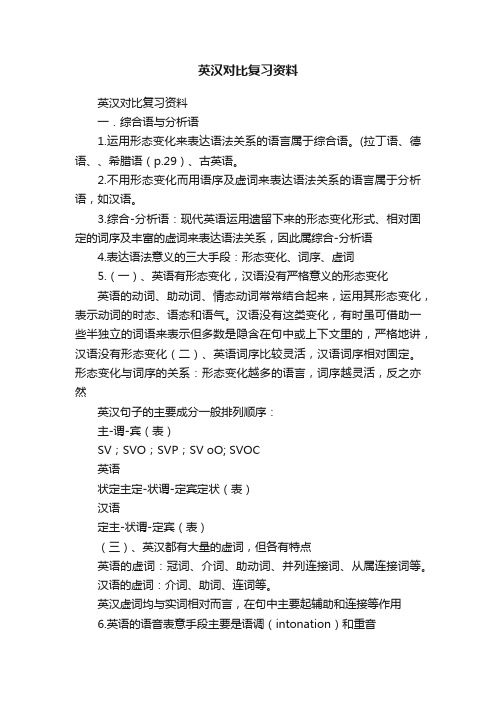
英汉对比复习资料英汉对比复习资料一.综合语与分析语1.运用形态变化来表达语法关系的语言属于综合语。
(拉丁语、德语、、希腊语(p.29)、古英语。
2.不用形态变化而用语序及虚词来表达语法关系的语言属于分析语,如汉语。
3.综合-分析语:现代英语运用遗留下来的形态变化形式、相对固定的词序及丰富的虚词来表达语法关系,因此属综合-分析语4.表达语法意义的三大手段:形态变化、词序、虚词5.(一)、英语有形态变化,汉语没有严格意义的形态变化英语的动词、助动词、情态动词常常结合起来,运用其形态变化,表示动词的时态、语态和语气。
汉语没有这类变化,有时虽可借助一些半独立的词语来表示但多数是隐含在句中或上下文里的,严格地讲,汉语没有形态变化(二)、英语词序比较灵活,汉语词序相对固定。
形态变化与词序的关系:形态变化越多的语言,词序越灵活,反之亦然英汉句子的主要成分一般排列顺序:主-谓-宾(表)SV;SVO;SVP;SV oO; SVOC英语状定主定-状谓-定宾定状(表)汉语定主-状谓-定宾(表)(三)、英汉都有大量的虚词,但各有特点英语的虚词:冠词、介词、助动词、并列连接词、从属连接词等。
汉语的虚词:介词、助词、连词等。
英汉虚词均与实词相对而言,在句中主要起辅助和连接等作用6.英语的语音表意手段主要是语调(intonation)和重音汉语的语音表意还有其他手段,如语调、重读与轻读。
二.刚性与柔性1.英语句型结构的刚性特征(聚集型),汉语句型结构的柔性特征(流散型)2.英语有综合语的特点,受形态约束,其语法具有刚性,没有弹性。
汉语是分析语,不受形态约束,其语法具柔性,富于弹性3.(1)英语基本句型:英语的刚性体现在句子有严谨的主谓结构。
即:名词性短语(NP)+ 动词性短语(VP)。
主语+ 谓语尽管英语句子错综复杂,千变万化,但其主谓结构可以归结为五种基本句型:SV, SVP, SVO, SVoO, SVOC(2)基本句型的扩展手段:增加修饰语、扩展基本句型的成分、基本句型的组合、基本句型的省略、倒装4.英语聚集型句式的成因:(1)聚集句子的手段众多(2)句子成分之间或词语之间必须在人称、数、性和意义等方面保持协调一致的关系5.汉语不受形态约束,无“主谓一致”之刚性要求,具有多样性、复杂性、灵活性等柔性特点,因而句式呈“流散型”。
英汉对比复习试题

1.共时研究和历时研究在英汉对比研究中的作用共时与历时是索绪尔语言学理论中的两个概念,他从符号的任意性出发,得出要区分语言的共时研究和历时研究,前者指研究在某一特定状态中的语言系统,不考虑时间因素;后者指研究语言的历史演变。
英汉对比语言学用的主要是共时的方法,注意其相似点,但更注意不似点,包括此有彼无、此多彼少,尤其是貌同实异的地方,如果可能,则尽量列举,以减少学习和翻译中的错误。
这种对比既可以是单向的,也可使是双向的。
前者以一种语言为参照语,另一种语言为对象语。
研究参照语的某种范畴、某种形式、某种意义等在对象语中如何表达,有何等价物;后者以某种范畴为基点,不分参照语和对象语,两种语言平行对比。
当然,共时对比并不排斥历时对比,因为任何语言从根本上说是不断演变的。
比如,有时在共时研究中为了说明某些问题会追溯到某一语言的历史演变。
2.汉英元音系统的对比1.单元音(1)英语单元音有12 个, 汉语有6 个。
英语单元音数量是汉语的一倍, 这说明英语单元音的音位区划分得更细。
汉语的单元音数量少, 这使得每个单元音承担的功能更多, 包括的音位变体就更多, 分布也更广, 因此代表的区域也就更大。
如英语有3 个央元音, 而汉语只有一个e , 但它却包括5 个变体:/e/měi (美)、/ε/y uē (约)、/ /wēn (温)、/ /gē(哥)、/ /wēng (翁)。
汉语单元音各个变体之间的差异较之于英语也更大。
(2)英语单元音具有汉语单元音所没有的一些区别性特征, 如音长和松紧。
一些单元音的长度可以造成意义的区别, 如/it/ (它)、/i t/(吃)、/ful/(满的)、/fu l/ (傻瓜)、/n t/ (不)、/n t/ (无,零)。
英语在发长元音时, 口腔肌肉紧张,音质平缓;发短元音时, 口腔肌肉松弛。
汉语的单元音不区别音长, 其长度一般介于英语长元音和短元音之间。
(3)汉语与英语单元音系统有许多类似的音,如,英语的[i:] 和汉语的[i]如闭口、非圆唇前元音, 半开半闭、非圆唇中元音, 闭口、圆唇后元音, 半闭圆唇后元音。
上海海事外应期末考试英汉对比知识点
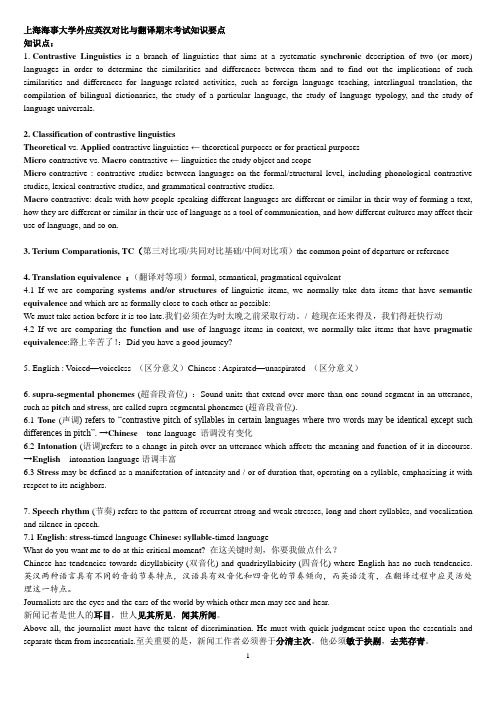
上海海事大学外应英汉对比与翻译期末考试知识要点知识点:1.Contrastive Linguistics is a branch of linguistics that aims at a systematic synchronic description of two (or more) languages in order to determine the similarities and differences between them and to find out the implications of such similarities and differences for language-related activities, such as foreign language teaching, interlingual translation, the compilation of bilingual dictionaries, the study of a particular language, the study of language typology, and the study of language universals.2. Classification of contrastive linguisticsTheoretical vs. Applied contrastive linguistics ← theoretical purposes or for practical purposesMicro-contrastive vs. Macro-contrastive ← linguistics the study object and scopeMicro-contrastive : contrastive studies between languages on the formal/structural level, including phonological contrastive studies, lexical contrastive studies, and grammatical contrastive studies.Macro-contrastive: deals with how people speaking different languages are different or similar in their way of forming a text, how they are different or similar in their use of language as a tool of communication, and how different cultures may affect their use of language, and so on.3. Terium Comparationis, TC(第三对比项/共同对比基础/中间对比项)the common point of departure or reference4. Translation equivalence :(翻译对等项)formal, semantical, pragmatical equivalent4.1 If we are comparing systems and/or structures of linguistic items, we normally take data items that have semantic equivalence and which are as formally close to each other as possible:We must take action before it is too late.我们必须在为时太晚之前采取行动。
英汉语言对比笔记

英汉对比研究(连淑能)Contrastive Studies of English and ChineseChapter 1 综合语与分析语( Syntactic vs. Analytic)1.综合语的特征是运用形态变化来表达语法关系。
A synthetic language is “characterized by frequent and systematic use of inflected forms to express grammatical relationships”。
如拉丁语,德语,古英语。
(in word level)2.分析语的特征是不用形态变化而用语序及虚词来表达语法关系。
An analytic language is “characterized by a relatively frequent use of functional words,auxiliary verbs,and changes in word order to express syntactic relations,rather than of inflected forms”。
如汉语。
Chinese is an isolating/analytic language. (in sentence level)3.Modern English is a syntactic-analytic language.(综合-分析语)English has got rid of most of its inflections, and expresses grammatical relations by devices like prepositions and auxiliary verbs and by the order of its words.4.实词:content words/full words/notion words虚词:structural words/form words/functional words5.形态变化(inflection)、语序(word order)、和虚词(function words)是表达语法关系的三大手段,三者之间有着密切的关系。
- 1、下载文档前请自行甄别文档内容的完整性,平台不提供额外的编辑、内容补充、找答案等附加服务。
- 2、"仅部分预览"的文档,不可在线预览部分如存在完整性等问题,可反馈申请退款(可完整预览的文档不适用该条件!)。
- 3、如文档侵犯您的权益,请联系客服反馈,我们会尽快为您处理(人工客服工作时间:9:00-18:30)。
, , a , , , , .
一般情感主义者喜欢用大字眼,称之为对于理想爱情的渴望。换言之,他们认为女人的情感平时只能零星发泄,必须有了丈夫和孩子,情感收聚起来有了归宿,自己才能得到满足。
1)a .
彩虹有多种颜色,外圈红,内圈紫。
2)a .
他有一种令人难堪的习惯:一会儿一个看法,自相矛盾,变化无常。
P107
6) ’s — .
这小伙子面相老实,性情随和,(因此)到处吃得开(有人缘)。
8).
在美国国土上,没有一座城市曾经遭受过如此严重的破坏。
10).
我有过两次不同场合的重要经历,这使我产生了一种几乎带有神秘色彩)一看到那棵大树,我便想起了童年的情景。
—.
2)近来忙于其他事务,未能早些复信,深感抱歉。
a .
第五章 物称与人称
P106
1) ’s , . ( : )
一踏上中华人民共和国国土,我们就随时随地受到关怀与照顾。
2) .
我兴奋得什么话也说不出来。
3) .(: 3200)
我走在厚厚的地毯上,一点脚步声也没有。
4) —— , .(W.: )
丽贝卡看见她周围的小姐那么福气,享受种种优越的权利,却有说不出的眼红。
3) a , . .
这是一次精心组织起来的会议。市政厅里济济一堂,热情洋溢,主持会议的是斯特朗先生。
4) a .
电流可以把动力传送到很远的地方,其消耗几乎可以忽略不计。
5)a .
当前,车辆横冲直闯,严重地威胁着城市生活,路上行人无不提心吊胆。
P79
2)人(若)不犯我,我(则)不犯人。
.
3)说是说了,没有结果。(=我虽然说了,但是没有结果。)
I 1.
4)凭良心讲,你待我礼貌有加,我却受之有愧。
I .
5)调查结果证明,他就是那婴儿的生父。
.
6)他走起路来,不知何时起给人一种庄重的印象。
A .
8)丛林中死一般沉寂,他还是毫无睡意。
a .
10)我觉得有三分怅惘,三分无奈。然而,思之又觉释然。
A a .
13)小梅心地善良,性情温和,对她朋友这种没有心肝的行为,实在看不顺眼。
’s ’s .
P110
6)A .
许多人由于消息不灵通,或者由于没有受过正规的教育训练,因此不能用一般都判读标准去判断这种新奇的现象。
7) ’s .
由于香港地理位置优越,加上免征各种进口税,这个东方城市长期以来成为各种进出亚洲货物的理想中转货运基地。
P111
4)I .
我感到很饿,又发现日影移动,这使我明白:自从我睡着以后,太阳已走了很长的路了。
, .
第六章 被动与主动
P125
1) . ( )
每逢假日的下午,我总要漫游周围的乡村。
2) .
在教堂里,人们不仅要有礼貌,而且应该有一种虔诚的态度。
3) , , .
人的思想形成了语言,而语言又影响了人的思想。
为什么如此众多的美国人不能如想象中那样幸福呢?我认为原因有二,而两者之间又有深浅之分。
a , , a , , a .
那是个天气晴朗,金黄可爱的秋天,美好的秋色为那些青年送别。待到战后和平时期,黄叶纷飞的秋天再度来临时,昔日的青年已经失去了青春。
, .
认为自己的思想深奥,不可能表达得很清楚,让任何人都能理解,这是言过其实。这样的作家当然不会想到,问题还是出在自己脑子缺乏精确思考的能力。
抵达伦敦的第一天上午,我就去参观大英博物馆。
6).
在西部沙漠,士兵们没有装甲车和大炮的掩护是不行的(是进不去的/是寸步难行的/是没有立足之地的)
P116
2)看树看果实,看人看作为。
A , a .
3)必须调整高等院校的专业设置,改进教学方法。
.
4)只要知道电压和电流,就能确定电阻。
.
5)当两个物体在一起摩擦时,电子便从一个物体转到另一个物体。
5).
谁想要理解拿破仑其人及其对近代欧洲所产生的影响,谁就得稍微注意他的家族特征。
1)a .
要掌握一门语言,必须下苦功夫。
2).
即使抄最近的路,也要花5小时才能到达那里。
4).
黄昏时分,人们发现这个小女孩在街上哭泣。
5)a .
只稍再经过几次失败,(我们)就能研制出价廉的人工心脏了。
P112
3)a .
P59
不到黄河不死心。
’s .
这姑娘长得漂亮,鹅蛋形脸,两眼又深又黑,披着又长又密的头发。
a , .
许多房子,盖着琉璃瓦,曲曲折折,无数的朱红栏杆。(吴敬梓:《儒林外史》)
.
第三章 形合与意合
P74
a .
过了一些时候,从远方传来了消息:在小铜球坠落的当天,确实发生了地震。这一切终于得到了澄清。
I , , .
I‟ , .
4)打肿脸充胖子,吃亏是自己。
, .
2)种瓜得瓜,种豆得豆。
, .
5)聪明一世,糊涂一时。
a , a 1.
6)不知苦中苦,哪知甜中甜?
, ?
第四章 繁复与简短
P96
1).
以前他们认为我们的经济计划是不现实的,行不通的,并以此聊以自慰,这样的岁月早已一去不复返。
2)) ?
对于与自己的救世活动密切相关的事情视而不见,充耳不闻的人,难道我们心甘情愿与之为伍吗?
P97
1) .
门口放着一堆雨伞,少说也有十二把,五颜六色,大小不一。(比较:门口放着至少有十二把五颜六色、大小不一的雨伞。)
2) I I .
我访问了一些地方,遇到了不少人。要谈起来,奇妙的事儿可多着哩。(比较:关于我所访问的一些地方和遇见的不少人有许多奇妙的故事可以讲。)
P100
2)因为距离远,又缺乏交通工具,农村社会是与外界隔绝的。这种隔绝状态,由于通讯工具不足,就变得更加严重了。
英汉对比研究期末考试重点:
第二章 刚性与柔性
P53.
a , a .
现在集成电路成了计算机的组成部分,使计算机的体积大大缩小,从而产生了新一代的袖珍式微型计算机。
“” “”.
谈判期间,各国的利益变化不断,好像万花筒似的,这就使人难以分辨出究竟谁是“胜者”,谁是“输家”。
A , ; a .
人们所知道的几千个星球并不比地球大多少,但绝大多数的星球却大得足以容下成千上万个地球还绰绰有余;我们到处都能遇见大得足以容纳千千万万个地球的巨星。
1 .
P101
4)他这时已是将近六旬的人,一表人才,高个儿,眉目清秀,头发又多又黑,略带花白,恰好衬出他那堂堂的仪表。
,a , .
5)我们不知不觉地朝公园走去。公园就在人行桥那边,桥下很深的地方,汹涌的河水滚滚流过。
。 .
6)倾刻之间,滚滚的浊水象堵墙一般压了下来,一古脑儿连人带车都给冲走了。这情景,直到现在还印在我的脑海里。
